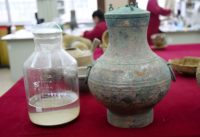 When archaeologists discovered 3.5 liters of fluid in a bronze vessel in a 2,000-year-old tomb in Luoyang, central China, last October, they thought it was wine. It was yellow and smelled of alcohol, similar in appearance and scent to rice wine. Other tombs dating to the Western Han Dynasty (202 B.C.- 8 A.D.) have been found to include rice or sorghum wine stored in elaborate bronze vessels and the alcohol was known to have played an important ritual role in funerary practices of the period.
When archaeologists discovered 3.5 liters of fluid in a bronze vessel in a 2,000-year-old tomb in Luoyang, central China, last October, they thought it was wine. It was yellow and smelled of alcohol, similar in appearance and scent to rice wine. Other tombs dating to the Western Han Dynasty (202 B.C.- 8 A.D.) have been found to include rice or sorghum wine stored in elaborate bronze vessels and the alcohol was known to have played an important ritual role in funerary practices of the period.
This find was of particular note because so much of the liquid had survived. The pot-bellied bronze vessel’s lid was still in place, and the seal was firm enough to prevent its evaporation. Laboratory testing on the fluid has found that the preliminary identification of grain wine was incorrect. It is not alcohol of any kind. In fact it is a mixture of potassium nitrate and alunite, an aluminium potassium sulfate mineral. These are two ingredients that according to ancient Taoist texts could be used to create an elixir of immortality.
Waidan, meaning external elixir, was the earliest branch of Chinese alchemy, focusing on the achievement of immortality by combining metals and chemicals in a bronze crucible. There are surviving texts going back to the second century B.C. that describe the artificial creation of elixirs of life. Mercury and lead were the foundation of most formulae and it might seem ironic that they are both deadly poisons but it isn’t, really, because the power to end life was seen as the other side of their putative power to extend life.
Taiost literature records many nobles, even emperors, having died from elixir of life poisoning. Qin Shi Huang, the first emperor of a united China who was entombed with the great Terracotta Army in a mausoleum complete with rivers of mercury, is said to have been the first emperor to die (in 210 B.C.) from elixir poisoning. The last killed by the search for immortality was the Yongzheng Emperor in 1735.
The elixirs themselves, despite their widespread popularity among the dead, are not often found in their resting places.
“It is the first time that mythical ‘immortality medicines’ have been found in China,” said Shi Jiazhen, head of the Institute of Cultural Relics and Archaeology in Luoyang.
“The liquid is of significant value for the study of ancient Chinese thoughts on achieving immortality and the evolution of Chinese civilization,” Shi added.
If you have an elixir of life, the quandary must be whether you test it first on some slave and then end up with a slave that outlives you, because you have too little left, or you risk death.
This is an amazing discovery to find 2,000-year-old vessels. This shows it in ancient time people use this type of vessels. :hattip: